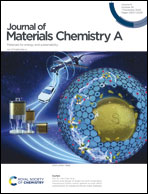Yolk–shell structured FeS/MoS2@nitrogen-doped carbon nanocubes with sufficient internal void space as an ultrastable anode for potassium-ion batteries†
Abstract
Transition metal chalcogenides (TMDs) suffer from undesirable electrochemical behavior induced by poor intrinsic conductivity and severe structural degradation when used as anodes for potassium-ion batteries (KIBs). Herein, we tackle this challenge via in situ construction of a uniform yolk–shell structure, in which the FeS/MoS2 nanoparticle yolk is completely confined in a N-doped carbon nanocube shell (FMC) with sufficient internal void space. The interior void space and external carbon shell can significantly buffer volume variation and enhance electronic conductivity. Meanwhile, the carbon shell can also inhibit particle self-aggregation, thus maintaining excellent structural integrity and further boosting cycling stability. Besides, the FMC provides favorable kinetics for both K+ and electron transport and promotes the reversibility of K+ storage along with a high pseudocapacitive contribution derived from the synergistic effect of the inner FeS and MoS2, enabling superior rate performance. Integrating the merits of the highly robust yolk–shell nanostructure, the resultant FMC anode manifests an excellent reversible depotassiation capacity of 333 mA h g−1 at 100 mA g−1 after 200 cycles, and unprecedented ultralong cycling stability with a remarkable capacity of 232 mA h g−1 over 10 000 cycles at 1000 mA g−1 with only 0.002% fading per cycle.



 Please wait while we load your content...
Please wait while we load your content...